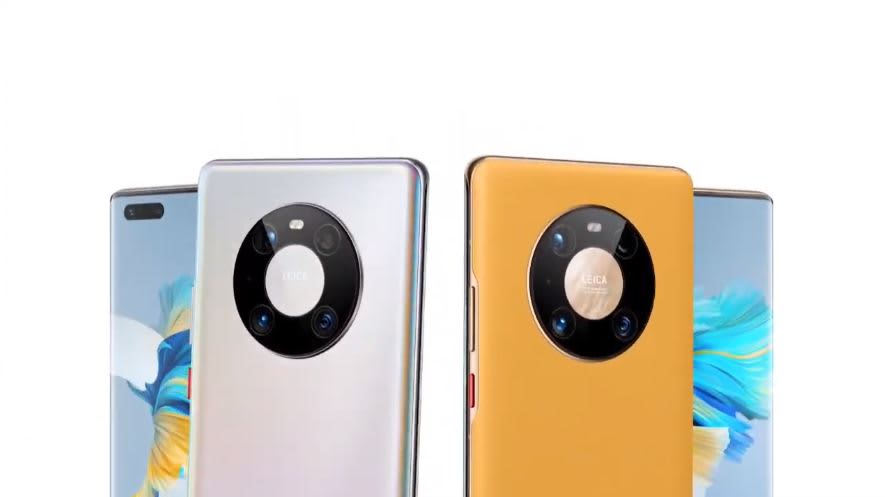
Huawei's new Mate 40 smartphone lineup.
Huawei
LONDON — Huawei unveiled its latest flagship smartphone lineup on Thursday, lacking Google services but touting a powerful new 5G chip as the company faces a semiconductor supply shortage due to U.S. sanctions.
The Chinese firm's new Mate 40 series consists of three models: the entry-level Mate 40, a more premium Mate Pro and the top-tier Mate 40 Pro+. It's Huawei's first phone to include a chipset made using the so-called 5-nanometer — or 5nm — process, a new standard in semiconductor manufacturing.
Called the Kirin 9000, Huawei's new chip is expected to pack a punch when it comes to performance as 5nm chips can house billions more transistors than that of current handsets. Apple's new iPhone 12 range also comes with a 5nm chip, the A14 Bionic. That should allow for improved energy efficiency and a smoother experience when playing games.
Like last year's Kirin 990, the Kirin 9000 comes with 5G capability, meaning it can connect to the latest mobile network standard which promises superfast internet speeds and quicker response times. Apple's latest iPhones and Samsung's Galaxy phones also support 5G.
Other standout features in the Huawei Mate 40 include:
- A quad-lens camera system on the back with a 50-megapixel main sensor.
- The ability to capture HDR, or high-dynamic-range, video for more vivid colors.
- An "AI tracking" mode that keeps a person within the frame when recording videos.
In terms of pricing, the Mate 40 will retail at 899 euros ($1,064), the Mate 40 Pro will sell for 1,199 euros and Mate Pro+ will cost 1,399 euros. It's also selling a luxury Porsche-branded version for 2,295 euros. The phones' display sizes range from 6.5 inches to 6.76 inches. It's not clear when they'll be available to buy.
Chip shortage
The outlook for Huawei's smartphone business has become more uncertain amid U.S. restrictions that effectively cut the Shenzhen-based firm off from some of its key suppliers. Last year, the U.S. Commerce Department added Huawei to a trade blacklist known as the Entity List, forcing Google to stop licensing its Android operating system to the company.
In an even bigger blow to the firm, Washington made it nigh on impossible for Huawei to obtain critical semiconductor equipment from foreign chipmakers. Huawei's custom Kirin chips are manufactured by TSMC, but the Taiwanese firm had to stop supplying Huawei last month due to the new rules.
The big challenge for Huawei will be filling the gap left by TSMC, and it is left with very few options. Richard Yu, the boss of Huawei's consumer division, has said the firm is facing a chip supply shortage: "This year may be the last generation of Huawei Kirin high-end chips."
"For Huawei nowadays, we are in a very difficult time," Yu said at a launch event for the new phones Thursday. "We are suffering from the U.S. government's third-round ban, this is an unfair ban making the situation extremely difficult for us."
Neil Shah, an analyst at Counterpoint Research, said he expects there to be "pent-up demand" for the Mate 40 series in China but added there's "little motivation" for iPhone users there to switch since Apple's new smartphones are now 5G-capable.
"Uncertainty around supply chain could hinder the supply and scale moving forward," Shah told CNBC, adding the "bulk of the demand will come from China" as Huawei struggles to convince international consumers to buy its phones over other Android-based devices like Samsung's.
The new phone unveiling also comes amid a resurgence of coronavirus restrictions in Europe, a key international market for Huawei. However, the company could benefit significantly from the recovery in China's economy, which grew 4.9% in the third quarter. Huawei briefly became the world's No. 1 smartphone maker earlier this year, thanks in no small part to strong sales in its home market.
As is the case with all new Huawei phones, none of the Mate 40 models come with the licensed version of Android or Google apps like YouTube and Maps. The company is trying to make up for that loss with rival search and maps apps under its own brand called Petal. While Google services aren't a big deal in China, where the U.S. tech giant's apps are blocked, they're much more important in international markets.
However, Huawei says it's made headway with mobile services, doubling the number of apps within its ecosystem to 96,000 year-on-year. The company is also set to power its smartphones with HarmonyOS, a rival to Android and iOS, next year.
October 22, 2020 at 08:35PM
https://ift.tt/37wJRwk
Huawei launches another Google-less flagship phone as U.S. sanctions threaten to halt chip supply - CNBC
https://ift.tt/3eIwkCL
Huawei
No comments:
Post a Comment